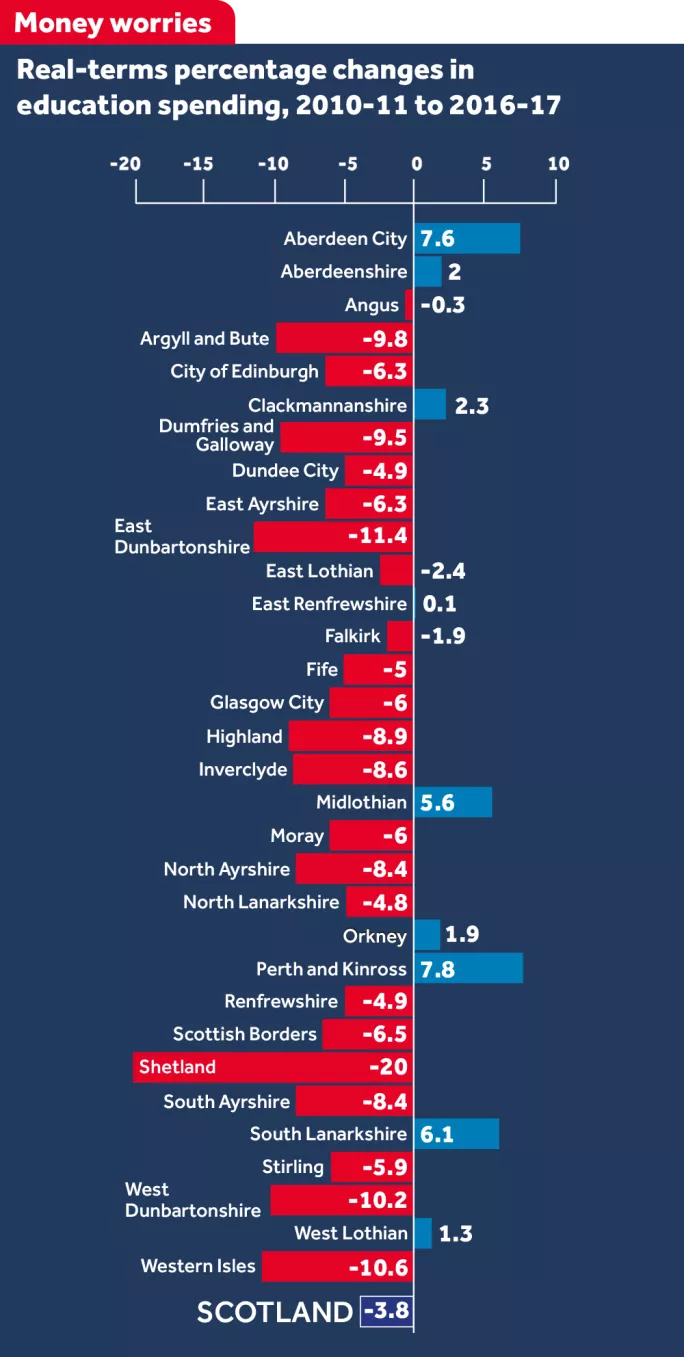Cuts create a ‘postcode lottery’ in education

At this time of year, when councils are setting their budgets, we are already hearing about cuts and increased charges covering everything from the number of teaching posts to the price of music lessons (“Councils have ‘scope to reduce teacher numbers’”, Tes Scotland, 23 February). Meanwhile, teachers say school budgets have seldom been tighter - and that they are having to pay for classroom supplies out of their own pockets.
A comprehensive picture of how funding for education has changed can be harder to make out. New figures obtained by Tes Scotland, however, lay bare the way that education spending has altered in all 32 Scottish councils. For most, it is bad news.
The figures, compiled by the councils, show that even with the money being pumped into local authorities by the Scottish government to boost disadvantaged pupils’ attainment, 23 of the 32 councils have cut their spending on education in real terms since 2010-11 (see figures, right). One council, Shetland, has cut its spending by a fifth.
Nine councils have cut their real-terms spending by around 10 per cent, ranging from 11.4 per cent in East Dunbartonshire to 8.4 per cent in North Ayrshire, according to the figures collated by the Improvement Service, a local government organisation. The smallest real-terms cut was 1.9 per cent, in Falkirk.
Pressure on budgets
There has been a real-terms rise in education spending in nine councils, with the most significant increase in Perth and Kinross, which invested 7.8 per cent more in real terms in 2016-17 than in 2010-11.
The figures emerged as the Scottish government this week celebrated 2016-17 education spending that in real terms was 2.3 per cent higher than in 2014-15, it said.
However, even with the Scottish Attainment Challenge money, most authorities are spending less in real terms than they did six years ago. Stephen McCabe, children and young people spokesman for councils umbrella body Cosla, says this is “undoubtedly” the case, given the pressure on local budgets in recent years.
Responding to the figures, the EIS teaching union has reiterated its calls for education budgets to be ring-fenced and for a national staffing formula for schools. It says the figures show “significant variance” in education investment across local authorities and “an emerging postcode lottery of provision”.
EIS general secretary Larry Flanagan says: “The impact of this reduced investment is increasingly clear in schools across Scotland, with reductions in staff numbers, a lack of learning resources and a detrimental impact on the learning experience for pupils. Education is an investment in the future of our young people, and all pupils deserve the same access to a high-quality educational experience in all parts of the country.”
‘Variations in spend’
There has been a gradual “drip, drip” of money out of education and now it is starting to affect “core services”, such as school libraries, says Jim Thewliss, general secretary of School Leaders Scotland.
“That will have a direct impact on attainment, especially for kids who come from deprived backgrounds,” he adds.
Bruce Robertson, a former Scottish government adviser and education director in Highland and Aberdeenshire, says the figures show an “unacceptable” postcode lottery.
“Education is a priority of the first minister [Nicola Sturgeon] and her government, yet we see these variations in spend. That is unacceptable. The standard of education should not depend on where you live,” he adds.
The government has “slashed” council budgets by £1.5 billion since 2011, says Scottish Labour education spokesman Iain Gray.
“The knock-on effect of that is fewer teachers with less time to deliver the support our young people need,” he says.
Meanwhile, McCabe says councils have “undoubtedly” made savings in education because of the pressure on their budgets in recent years and this is likely to get worse with public-sector pay rises, including the 10 per cent pay claim being pursued by teachers.
However, ring-fencing education funding would lead to other council services being “decimated”, he says. Instead he wants councils to be “properly funded” by the Scottish government and the 3 per cent cap on council tax rises lifted.
“Overall, against this backdrop of reducing investment, councils are still performing well,” McCabe adds.
‘Lack of transparency’
After Shetland, the biggest fall in spending on education was in East Dunbartonshire, where the Improvement Service recorded a 11.4 per cent real-terms drop. The council says its per-pupil spend is “consistent with similar councils”. Its figures show a significant drop in spending, but it says this was not because of an actual reduction but rather a change in the way figures were collated.
Ann Davie, East Dunbartonshire depute chief executive for education, says: “Costs that were previously incurred - and continue to be incurred - are now excluded. This change was to ensure that figures across Scotland were directly comparable.”
Education secretary John Swinney highlights that education spending has risen in real terms since 2014-15 and that the budget the Scottish Parliament passed in February will deliver a real-terms increase in next year’s council funding.
However, he also says that the way funding is allocated to schools is “complex, lacks transparency and varies from council to council” - and the government wants “the schools themselves” to take more of the decisions on funding. Swinney adds: “To help achieve this, we committed £120 million to our Pupil Equity Fund this year. This additional money is available to headteachers to address some of the specific issues that might be affecting poverty-related attainment in their schools.”

You need a Tes subscription to read this article
Subscribe now to read this article and get other subscriber-only content:
- Unlimited access to all Tes magazine content
- Exclusive subscriber-only stories
- Award-winning email newsletters
Already a subscriber? Log in
You need a subscription to read this article
Subscribe now to read this article and get other subscriber-only content, including:
- Unlimited access to all Tes magazine content
- Exclusive subscriber-only stories
- Award-winning email newsletters